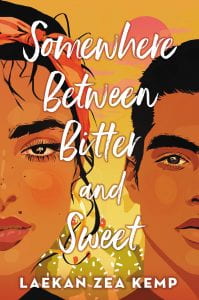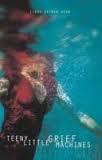 Kemp, Laekan Zea. Somewhere Between Bitter and Sweet. Little, Brown and Company, 2021. 978-0-316-46027-9, 343 p. $17.99. Grades 8-12.
Kemp, Laekan Zea. Somewhere Between Bitter and Sweet. Little, Brown and Company, 2021. 978-0-316-46027-9, 343 p. $17.99. Grades 8-12.
Somewhere Between Bitter and Sweet hits all the right notes for a young person’s fantasy romance. In alternating narratives, the reader follows the growing romance between talented Mexican-American chef, Penelope (Pen) Parado, and undocumented restaurant worker, Xander Amaro. Nachos Tacos is Pen’s father’s restaurant in Austin, Texas, and the salvation of the neighborhood, providing a handout or employment to many, despite the glaring threat of a ruthless loan shark, J.P. Martello. The restaurant is dear to Pen’s heart–not only because it is there she can express her culinary skills–but also because of the sense of family it represents. She is devastated when she is banished from the restaurant after confessing to her parents that she has not attended a full semester of nursing school. Traditional Mr. Parado expects his older son, Angel, to carry on the business despite Angel’s disinterest. New employee, Xander, enters the wait staff on Pen’s last day, and though some point out her brash, bossy manner, he is smitten. Eighteen-year old, independent Pen finds a cheap apartment with the help of bff Chloe and a wretched job at a Taco Bell-like establishment. In spite of her take-charge personality, Pen suffers from self esteem issues and the narrative alludes to some self-harming; she does take medication for her low moods. In addition to being undocumented, Xander is actively searching for his father who left the family when Xander was a toddler and has never attempted contact with either Xander or his own father, Xander’s guardian. As the narration asserts, each has their own scars. The chapters develop with Pen dealing positively with her complicated love-hate relationship with her father and Xander’s appreciation of his feelings of belonging to the ragtag Nacho crew. Their days revolve around working in their respective restaurants, hanging out with the other Nacho workers, food, and their romance until the restaurant’s future is in jeopardy from the menacing loan shark. This antagonist brings the needed friction for the story, culminating in a predictable conclusion that leaves the reader with admiration for the resiliency of Pen and Xander and their Latinx neighborhood.
THOUGHTS: There is nothing too deep here or too risky (Pen and Xander have some deep kisses and smoldering feelings, but nothing more; some foul language and drinking). Latinx author Kemp tells an old-fashioned love story with the typical tropes but with more interesting words and the addition of some mental health and immigration issues. Her major and minor characters are likeable and developed. One unexpected relationship is Xander’s friendship with the local police officers, despite his undocumented status. Younger teens wanting a romance or older ones looking for an escape novel will be hooked.
Realistic Fiction Bernadette Cooke, School District of Philadelphia


